Table of Contents
Most people bidding for a government contract run into this early: a mention of EMD, or Earnest Money Deposit. It’s not always explained well, but it matters — skip it, and your bid doesn’t even make the cut.
At its core, EMD is a way to prove you’re serious. It’s a sum you pay when submitting your tender. Not a fee, exactly — more like a temporary deposit. It tells the buyer, “I’m in this for real. I’ve read the scope. I’m ready to deliver.”
This stops casual bidders from crowding the process or walking away after being shortlisted. For the department issuing the tender, it saves time. For businesses, it adds a layer of responsibility.
You’ll find the exact amount in the tender notice. Sometimes it’s a flat rate, other times it’s a percentage of the total contract value. In some cases — especially if you’re a registered MSME — you won’t have to pay it at all.
If you’re planning to bid, you’ll want to understand how EMD works: when to pay it, how much, whether you can get it back, and what rules apply if you back out.
Why Is EMD Required?
Because too many bidders back out.
When a department floats a tender, they expect serious responses. But without EMD, they’d be flooded with half-baked bids — some from vendors who never planned to follow through. EMD changes that.
It’s a simple filter: you pay a deposit when you bid. Not a small token, either. It stings just enough to make you think twice. Are you really ready to take this project on? Have you understood the scope? Can you deliver if selected? If yes, you’ll pay the EMD without flinching. If not, you’ll walk away — and that’s exactly the point.
From the buyer’s side, it protects the process. Evaluating tenders isn’t a five-minute job. When someone drops out midway or rejects the offer after being selected, it derails timelines. EMD discourages that behaviour. If you vanish, they keep your money.
Most government buyers treat EMD as non-negotiable. If it’s mentioned in the document and you don’t submit it, your bid won’t be opened. It’s rejected at the doorstep.
You’ll see EMD used more often in high-value contracts — infrastructure, engineering, large-scale procurement. Smaller jobs might skip it. MSMEs are sometimes exempt. But in most cases, when it’s asked for, it’s mandatory.
EMD isn’t there to make the bidder’s life harder. It’s there to keep things serious, structured, and fair.
How to Calculate EMD
The amount you need to deposit as EMD depends on how big the contract is. It’s not a flat fee — it’s a percentage of the estimated project cost. Most tenders put this somewhere between 2% and 5%.
Here’s how you figure it out:
Take the estimated tender value and multiply it by the rate mentioned in the tender. That’s your EMD.
For example, if the contract is worth ₹3 crore and the EMD is set at 2%, then:
EMD = ₹3,00,00,000 × 2% = ₹6,00,000
That ₹6 lakh needs to be paid in full, using whatever method the department allows. Could be a demand draft, sometimes a bank guarantee, or online transfer — depends on who’s issuing the tender.
Some tenders don’t give you a percentage. They’ll just write, “EMD payable: ₹50,000.” In that case, don’t bother calculating anything — just pay the stated amount.
Always check the fine print. There’s usually a section called “EMD Details” or “Bid Security” in the document. That’s where you’ll find how much to pay, how to pay it, who to make it out to, and whether you qualify for exemption. If you’re an MSME or Startup, you might not have to pay it at all — but you’ll still need to upload proof.
And whatever you do, don’t guess. If you send the wrong amount or miss the payment deadline, your bid goes out the window — even if everything else is perfect.
EMD Refund Rules & Forfeiture
If you don’t win the tender, your EMD is returned. That’s the basic rule. Most departments process refunds within a few weeks of finalising the award. Some take longer. Either way, if you haven’t violated any conditions, you’ll get your money back.
Now, here’s where it gets tricky.
If you mess up — say, you withdraw your bid after the deadline or refuse to accept the contract if you win — that money is gone. No appeals. The department keeps it. It’s called forfeiture, and it happens more often than you’d think.
Here are the most common reasons EMD gets forfeited:
- You back out after the bid has been submitted
- You modify your offer during the evaluation period
- You win the tender but refuse to sign the agreement
- You fail to start the work on time
- You don’t furnish the performance guarantee after award (if required)
The idea behind all this is simple: accountability. EMD exists to discourage casual bids. Once the bid is in, you’re expected to stand by it. If you can’t, or don’t, the department has every right to recover their time and effort through the deposit.
Most refunds happen through NEFT or bank transfer these days, but some older departments still use cheques or ask you to submit a written request. It varies.
One last point — read the tender document. Some buyers refund EMD automatically. Others expect you to raise a formal claim after the LOA (Letter of Award) is issued to someone else. If you don’t follow the process, your refund could get stuck for weeks or even months.
EMD vs Security Deposit vs Tender Fee
These three terms — EMD, security deposit, and tender fee — get tossed around in every tender, and they’re not the same thing. Mix them up, and you risk paying the wrong amount or missing something entirely.
EMD (Earnest Money Deposit)
This is paid at the time of submitting your bid. It’s a show of intent. You’re telling the buyer, “I’m serious about this contract.” If you win, it might get adjusted or held temporarily until you furnish the security deposit. If you lose, and haven’t broken any rules, it gets refunded.
Security Deposit
This comes after the contract is awarded. It’s usually around 5% to 10% of the total contract value and must be submitted before work begins. The purpose is to safeguard the buyer in case you default midway or fail to meet the terms. Unlike EMD, this stays with the buyer until the project is completed — sometimes even longer, depending on the defect liability period.
Tender Fee
This one is simple: it’s a non-refundable charge just to access the tender document. It might be ₹500, ₹1,000, or more depending on the department. You pay it even before uploading your bid. MSMEs are often exempt from paying this, but you’ll need to submit proof — usually your Udyam or NSIC certificate.
Quick breakdown:
- EMD = Refundable, paid at bid submission
- Security Deposit = Refundable, paid after award
- Tender Fee = Non-refundable, paid upfront
Each one serves a different purpose. One shows commitment, one ensures performance, and one just covers administrative costs. Treat them accordingly.
MSME Exemption under Rule 170
If you’re a registered MSME, you might not need to pay the EMD at all. This comes from Rule 170 under the General Financial Rules — it’s been around since 2017, and most departments follow it.
But don’t assume it applies automatically.
You need to be officially registered — Udyam, NSIC, or under Startup India (DPIIT). Even then, the exemption only works if the buyer allows it. Not all departments do. And even when they do, they expect your documents to be in order.
What actually matters:
- First, you must attach your registration. A valid Udyam certificate, current NSIC license, or DPIIT recognition letter. If you forget, you’ll be treated like everyone else.
- Second, your registration has to match what the tender is for. If you’re listed as a service provider but the tender is for manufacturing, it won’t work.
- Third — and this one’s often missed — many tenders now ask MSMEs to upload a Bid Security Declaration instead of paying EMD. It’s a simple one-pager saying you won’t back out. If you skip it, your bid’s incomplete.
Also: some portals still show “EMD required” even when MSME exemption is allowed. That’s just how they’re set up. Ignore the payment prompt — upload your certificate, attach the declaration, and move on. If it still deducts your amount, flag it immediately. Don’t wait for bid opening.
One more thing: exemption doesn’t mean you’re immune from all conditions. If you misuse it — say, back out after winning — the department can blacklist your firm. Or suspend you from future bids. It’s rare, but it happens.
So yes, MSME exemption can save you lakhs. But only if you follow the steps exactly. One missed document, and it’s like the exemption never existed.
How to Submit EMD Correctly
For all the work that goes into preparing a tender, the EMD part should be the easy bit. And yet, it’s one of the most common reasons bids get rejected. Why? Because most bidders rush through it, assume the process is standard, or use the same instrument they used in the last tender.
Don’t. Every tender has its own EMD instructions — and even a small mistake can cost you the bid.
Step 1: Read the EMD Terms Carefully
Start with the section usually titled “EMD Details,” “Bid Security,” or “Tender Fee and EMD.” This will tell you:
- Whether EMD is required or exempted
- The exact amount or percentage
- Accepted payment modes (DD, FDR, BG, NEFT, etc.)
- To whom the instrument should be addressed
- Where it should be payable (usually a city or specific office)
- Validity period (especially important for BGs)
- Cut-off date and time for submission
Miss any of these, and your bid is likely to be disqualified — regardless of how good your offer is.
Step 2: Choose the Correct Mode of Payment
Here are the most common options:
Demand Draft (DD)
- Must be in favour of the buyer (name and designation as specified)
- Should be payable at the location mentioned (e.g., “Payable at Delhi”)
- Needs to be valid until the date mentioned (usually 60–90 days)
Fixed Deposit Receipt (FDR)
- Issued by your bank, pledged to the buyer
- Must be physically submitted if the department asks for originals
Bank Guarantee (BG)
- Used for high-value tenders
- Must be from a nationalised or scheduled bank
- Validity period is often 180 days or more
- Must follow the exact format prescribed (many buyers attach a sample BG format)
NEFT/RTGS (Electronic Transfer)
- Increasingly common in e-tendering platforms
- Must be transferred to the specified account (check IFSC, branch)
- Upload proof of transaction (PDF, screenshot)
Note: The mode isn’t optional. If the tender says “BG only”, a DD won’t be accepted — even if it’s the right amount.
Step 3: Prepare and Attach the Right Documents
Here’s what you’ll usually need:
- Scanned copy of the EMD instrument (PDF or JPG)
- Original instrument (if required for offline submission or courier)
- Covering letter with reference details (especially for DD/BG)
- Bid Security Declaration (if you’re claiming exemption)
- MSME/Udyam certificate (if claiming exemption under Rule 170)
Step 4: Submit Before Deadline — Not Minutes Before
In e-tendering, the system may lock you out of submission if the EMD isn’t uploaded before the technical bid. Some portals validate the payment in real-time; others let you proceed but flag it later.
If a hardcopy is required (BG, DD, etc.), make sure:
- It reaches the buyer before the technical bid opening
- It’s labelled properly — tender ID, firm name, contact details
- You get an acknowledgement, if the department issues one
Step 5: Double-Check Before Submitting
Before you click “Submit Bid” on any portal or courier hardcopies, run through this checklist:
- Is the EMD amount accurate?
- Did you use the accepted mode of payment?
- Is the payee name correct, exactly as mentioned?
- Does the validity meet the requirement?
- Have you uploaded all the required files?
- If exempt, have you uploaded the right documents and the declaration?
- If sending originals, are they labeled clearly and sent to the correct address?
What Happens If You Get It Wrong?
Here’s the reality: no matter how good your pricing or documents are, if the EMD is wrong or missing, your bid will be rejected without further review.
Common rejections include:
- EMD paid to the wrong entity
- BG/FDR with insufficient validity
- MSME exemption claimed without documents
- DD amount short by a few rupees
- Declaration form missing
Most departments will not call you for clarification. They’ll move on to the next compliant bid.
Final Tip: Treat EMD like a compliance form — not a payment. It’s a test to see if you’ve read the tender properly. If you get it right, you move forward. If you get it wrong, the door closes, no matter how strong the rest of your bid is.
Conclusion
If there’s one thing that knocks out more tenders than pricing or paperwork, it’s EMD. People treat it like a minor step — a box to tick. It isn’t.
Get it right, and you’re through to evaluation. Get it wrong, and that’s the end of the road — doesn’t matter how good the rest of your bid is.
Check the amount. Check who it’s payable to. Don’t assume you’re exempt unless the document says so — and even then, make sure your certificate matches the item or service in the tender.
And if you’re not sure about something, don’t guess. Pick up the phone. Email the department. Clarify before you submit. You don’t get a second shot after the deadline passes.
EMD’s not hard. But it demands attention. Slow down, read the fine print, and cover every detail. It’s that simple.
Priyanka is a seasoned content marketing professional with more than 6 years of experience crafting various forms of business and technology sector content. Her insightful writing tackles critical issues faced by small-scale manufacturing businesses. Priyanka's clear and concise communication empowers businesses to make informed decisions and thrive in today's dynamic business environment.
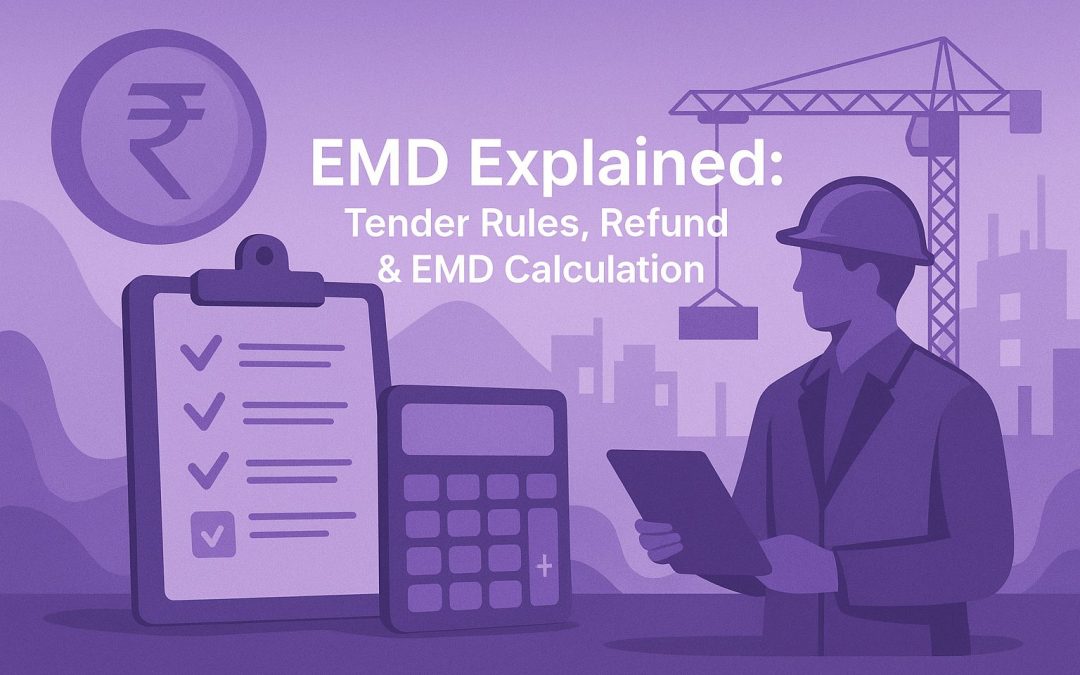

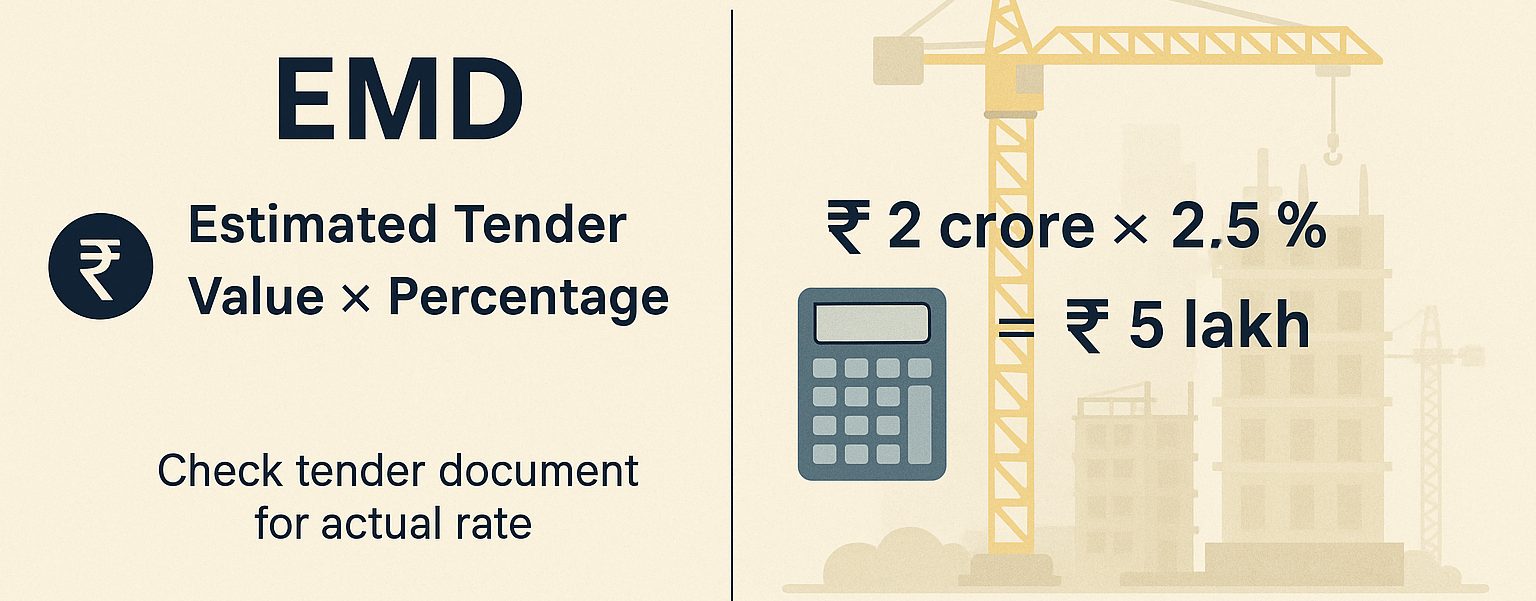
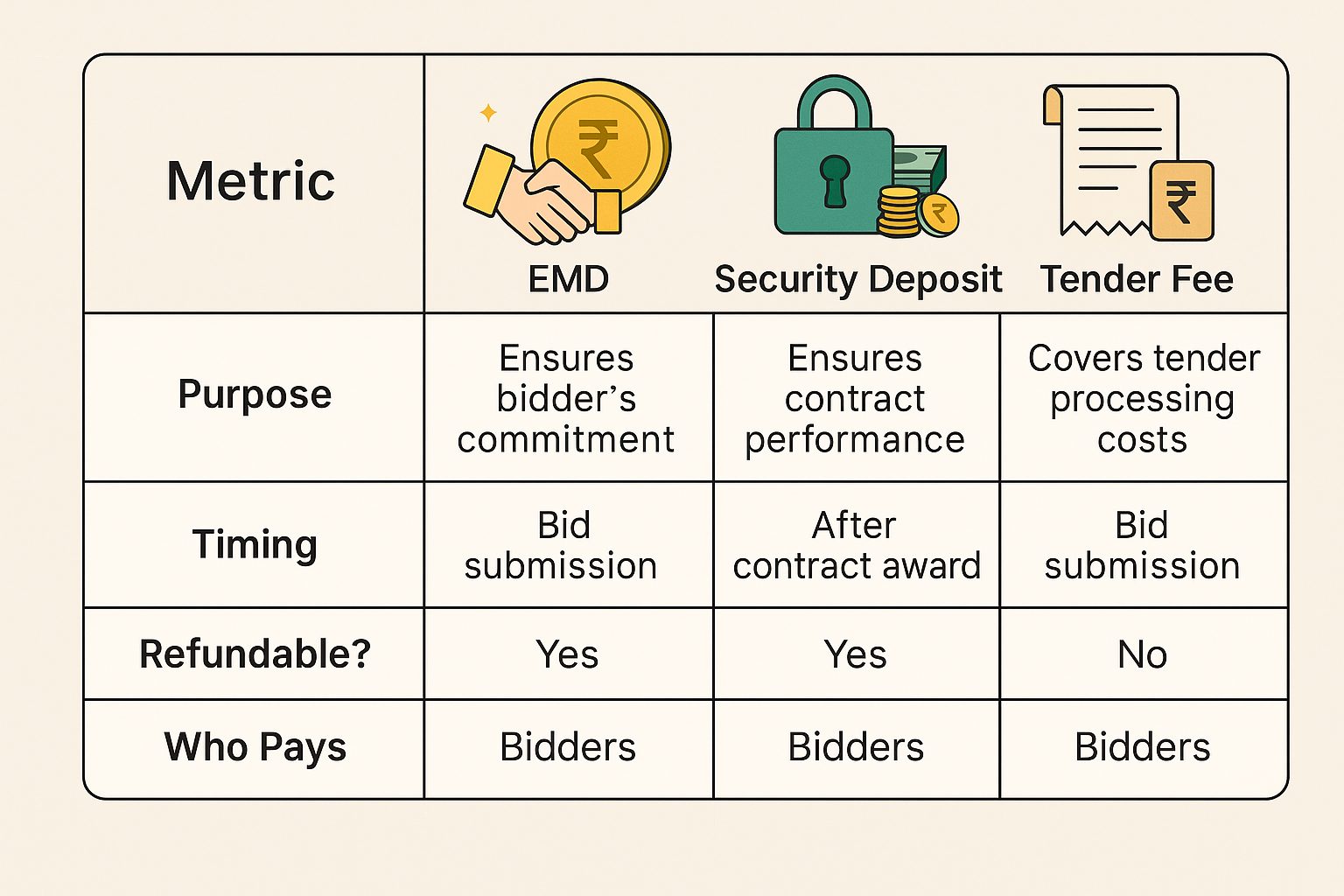
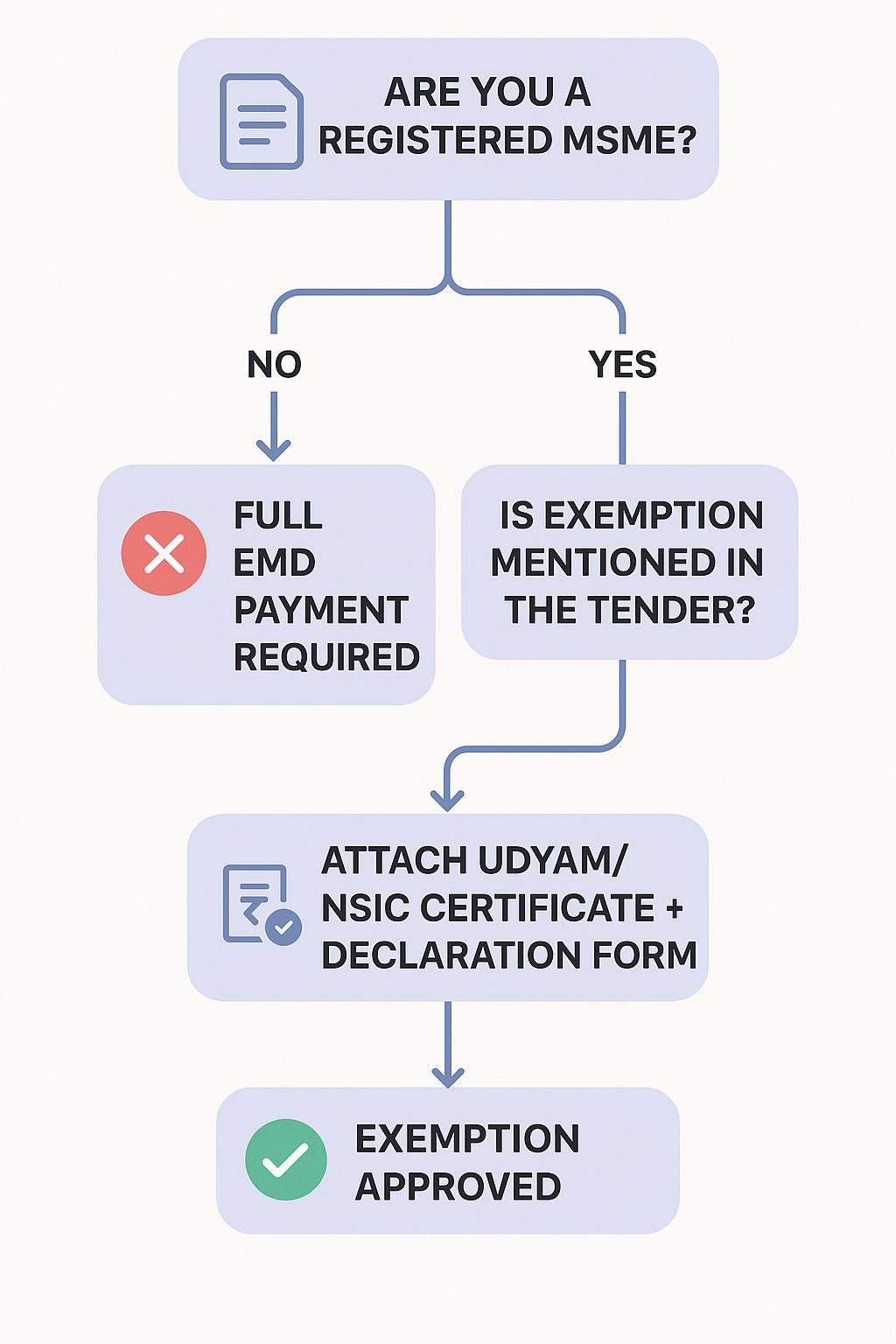




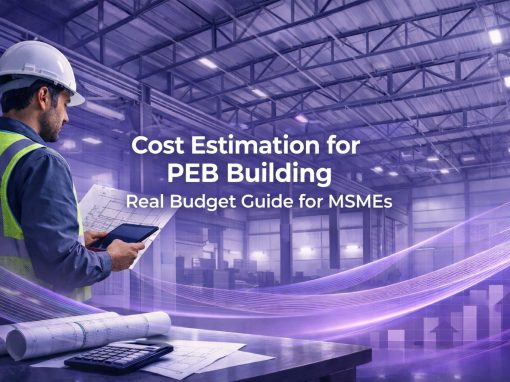


Are there any cases where the EMD may not be refundable, even for non-successful bidders? Like, if error was found in the bid after submission?
If the bidder withdraws their bid during the bid validity period or if there are significant errors or discrepancies in the bid documents, the EMD can be forfeited.
The article mentions a “Bid Security Declaration” instead of EMD. What is that and is it a better option for my business sometimes? I handle logistics operations in the Maharashtra region.
Bid Security Declaration (BSD) is an alternative to EMD for micro and small enterprises (MSEs) that don’t want to tie up capital. It’s a declaration of commitment rather than a cash deposit. Choose BSD if you’re confident in your bid and can fulfill the tender conditions, otherwise, the EMD might be a safer choice.
Are companies falling in medium category in msme are eligible for exemption of railway tenders for not paying EMD n tender fees
Despite of successful accomplishment & handover of the Govt. Tender Job(s) by the Tenderer, can an intermediary (GOI Entp.) who does all the processes of floating open Tenders / conducting Tenders for & on behalf the principals / another GOI Entps. / Tenderee, still with holds EMD / SD Money for seek of NOC from principals / Tendree (as well as intermediary) who acknowledges the Handover but wilfully ignores to any prayers of the Tenderer & ultimately does not Issues any Proper NOC?
That the said intermediary (A GOI Entp.) under whose custody these EMDs / SDs / other deposits are lying, can they really retain / Forfeit such genuine (Public Money) of the Tenderer’s EMD / SD / other Deposits only on the grounds of e Contrat)absence of NOC?
Are there any corrective steps (Exclusions) in order to Refund back such Monies to the Genuine & innocent Tenderers??
I can’t stress enough how important it is to meticulously examine the tender notice. I once missed a detail about the acceptable format for the EMD (demand draft only), leading to more complications. So good thing you covered this.
This made me realize I need to get my MSME registration ASAP. I didn’t know it could save me money on tenders.
we have paid EMD & tender fee, but due to technical reason we have not submitted the Bid” in this case how we ask for EMD & tender fee refund
I’m a bit unclear about when exactly the EMD will be forfeited. The article mentions withdrawal of the bid or failure to enter into a contract, but what happens if a bidder faces unavoidable circumstances that delay their acceptance? Is there any leeway?
Can we return the EMD at the end of Validity of Offer period and still extend the term of Validity of offer
20% se jyda below tender rate rkhne pr kitne percent jyda fd jama Krna pdta hai